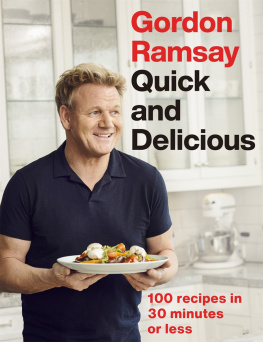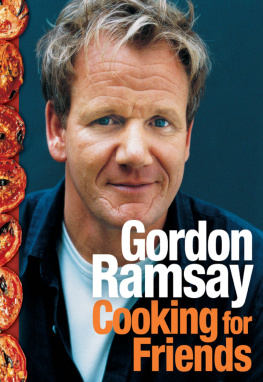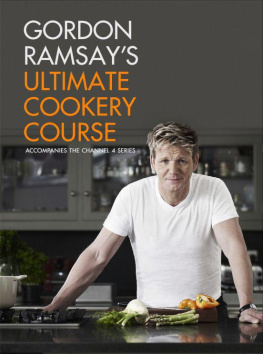
Text copyright 2012 by Gordon Ramsay
Program, Program Material and Format copyright 2012 by One Potato, Two Potato Limited
Photography copyright 2012 Anders Schnnemann
. Thank you for your support of the authors rights.
Grand Central Life & Style
Hachette Book Group
237 Park Avenue
New York, NY 10017
www.GrandCentralLifeandStyle.com
Q-MA
Originally published in Great Britain in 2012 by Hodder & Stoughton, a Hachette UK Company.
First US Edition: April 2013
Grand Central Life & Style is an imprint of Grand
Central Publishing.
The Grand Central Life & Style name and logo are trademarks of Hachette Book Group, Inc.
The Hachette Speakers Bureau provides a wide range of authors for speaking events. To find out more, go to www.HachetteSpeakersBureau.com or call (866) 376-6591.
The publisher is not responsible for websites (or their content) that are not owned by the publisher.
Library of Congress Control Number: 2012953718
eISBN: 978-1-455-52526-3

CONTENTS

A DECADE OR SO AGO, THERE WAS A FASHION FOR MICHELIN-STARRED CHEFS TO PRODUCE THESE INCREDIBLY COMPLICATED COOKBOOKS.
You know the sort of thing I meanwhere following one recipe meant you had to turn to five other recipes to prepare the various stages before you could even begin to tackle the featured dish. It was crazy, and completely failed to recognize that home cooking and restaurant cooking are two very different things.
So the first thing I want to do is to reassure you that this book isnt going to be anything like that. Im not setting out to turn you into Michelin-starred chefs here. Im not expecting you to spend hours bent over plates, tweaking and primping in pursuit of perfection. I just want to teach you how to cook and enjoy good food at home. Im going to strip away all the hard graft and complexity and show how, from humble beginnings, anyone can produce mouth-watering recipes. Put simply, Im going to show you how to cook yourself into a better cook.
Not that Im turning my back on my experience. Over the past 25 years Ive been lucky enough to work with some of the best chefs in the world, from Albert and Michel Roux in London to Guy Savoy and Joel Robuchon in Paris. Ive held Michelin stars in many of the major cities of the world, including three at Restaurant Gordon Ramsay in London for more than 10 years now. Like all chefs, Ive learned an incredible amount along the way: techniques, trickscheats, eventhat I incorporate instinctively into my cooking every day. Half the time I dont even know Im using them, but they are always there, giving me confidence in the kitchen.
And believe me, the best thing you can have in a kitchen is confidence. I really think thats what separates good cooks from the mediocre ones. Sure, you need to be able to taste and to master a few basics, but being able to act boldly and decisively, to have the confidence to ramp up the seasoning, for example, or to turn the gas up high and use the heat to your advantagethats the real secret. Thats what takes your cooking to another level.
Some people say they cant cookthat given half a chance, theyll burn water. I just dont buy that. I think theyre just not very interested in trying. Fair enough. Im not interested in needlepoint and Ill tell you that I cant sew. But in truth, theres no one with a genuine interest in learning who cant improve and, with enough practice, become a decent cook. They might not get to the stage where they can hold down a job in a professional kitchen, but they can learn to produce good home cooking and to get pleasure from it. And if you are already a good cook? Well, thats the great thing about cookingtheres always something new to learn, another way of doing things, a different way of combining flavors that takes a recipe in a new direction.

So where do we start? With the absolute basics, of course. Before you even get to turn on the gas, the first job in any new kitchen is always, always, always to get to know your environment, to get familiar with the layout and be comfortable with the location of everything in your kitchen. Are the pans within easy reach? Are your sieves close at hand? Im not talking about major DIY here. Im not suggesting you need to rip out your kitchen sink and shift it across the room. Its just a question of getting yourself familiar with where everything is. You dont want to be just about to finish off your risotto and have to spend 10 minutes looking for the cheese grater. Thats the kind of thing that throws you off your stride and from then on youll be playing catch-up.
Time spent getting yourself ready is never wasted. Get out the ingredients and the equipment you need. This mise-en-place, as we call it, is crucial. It sets you off on a calm course and takes the stress out of cooking. Without it, any professional kitchen would be dead in the water, and its equally important for the home cook too. Get it right and you have won 90 percent of the battle.
KITCHEN EQUIPMENT
Speaking of equipment, what do you need? Less than you might think. Im always suspicious of people who have every gadget under the sun because I suspect they collect them as a kind of displacement therapy, to make up for the lack of cooking they actually do. Like a footballer whos afraid to make a tackle for fear of getting grass stains on his uniform, they line up their blenders and juicers and pasta machines to look the part, and then let them collect dust. Better to be a poorly equipped doer than an over-equipped poseur.
Essential kitchen equipment starts and pretty much finishes with a good set of knives and pans. Armed with these, there are not a lot of jobs you cant tackle. A knife will do the job of both food processor and garlic press, a pan can be both meat mallet and flan tin. Buy the best quality you can, and by that I dont necessarily mean the most expensiveas in everything, youll sometimes pay dearly for fashionable brandsbut I do mean something built to last. Spend the money now and these kitchen workhorses will last you a lifetime, saving you a fortune in the long run.

HOW TO CHOP AN ONION
- Cut the onion in half lengthwise, going through the pointed end and the root. Peel off the papery skin to get to the shiny layers, but leave the root intact or the juices will start to bleed and make you cry.
- Make a series of parallel vertical cuts down the length of the onion, stopping just short of the root.
- Holding the onion steady, make two horizontal cuts through the onion, again stopping just short of the root.
- Now grip the onion like a tennis ball to hold it together, pushing down with your forefinger, middle finger, and ring finger on top and thumb and pinkie at the sides. Have your middle finger slightly ahead of its two neighbors and use the knuckle to guide the knife down to make repeated slices, inching your fingers back toward the root as you go.
- You should be left with a pile of neatly diced onion, and a root, which you can trim more if you like or reserve for the stockpot.
Next page
















